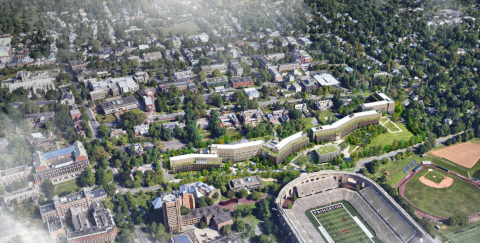
Princeton University Environmental Studies and The School of Engineering and Applied Science
A new precinct of research and teaching buildings optimizes critical adjacencies among departments and creates vibrant spaces that cultivate a collaborative research community. The design prioritizes Princeton’s goals to foster interdisciplinary collaboration at varying scales, creates a distinct identity for each department, establishes strong connections to nature, optimizes critical adjacencies, and promotes the University’s sustainability ethos.
The project moves the departments of Environmental Studies (ES) and School of Engineering and Applied Science (SEAS) out of their historic, outdated facilities and co-locates them in state-of-the-art buildings where they can conduct ground-breaking research. The new buildings are stitched into the existing campus circulation network to promote connectivity and collaboration with other departments across campus.
The topography of the site allows for the buildings to be nestled into the hillside, creating a completely connected first floor, which is populated with shared university programs like classrooms, teaching labs, and a café. The individual buildings then separately rise above the first-floor podium to provide unique identities for each department as well as to reduce the appearance of the building mass above-grade so that the design is sensitive to the scale of adjacent eating clubs and the residential neighborhood.
The ES building, which includes the High Meadows Environmental Institute, the department of Ecology and Evolutionary Biology, and the department of Geosciences, and the BioE + CBE buildings provide research and teaching labs, collaboration spaces at all scales, offices and workstations, administrative suites, classrooms, lecture halls, and shared outdoor spaces.
Details
- Year
- 2025
- Location
- Princeton, NJ
- Size
- 665,700 GSF
- Program
- Research Labs (Wet, Dry, And Hybrid), Core Research Labs, Greenhouses, Teaching Labs, Faculty and Administrative Offices, Workstations & Study Spaces, Conference Rooms, Collaboration Spaces, Classrooms & Lecture Rooms, Shared Outdoor Spaces For Gathering and Teaching, Loading Docks, Science Library, Café, Multi-purpose Room, Visualization Lab
Team
- Design Partner
- Richard Olcott
- Management Partner
- Molly McGowan
- Project Architect
- Craig McIlhenny
- Project Manager
- Emily Kirkland
- Project Designer
- Melanie Weismiller
- Sustainability Director
- Stefan Knust
- Project Designer
- Kevin Hamlett
- Project Architect
- Matthew Dionne, Peter Broughton



















